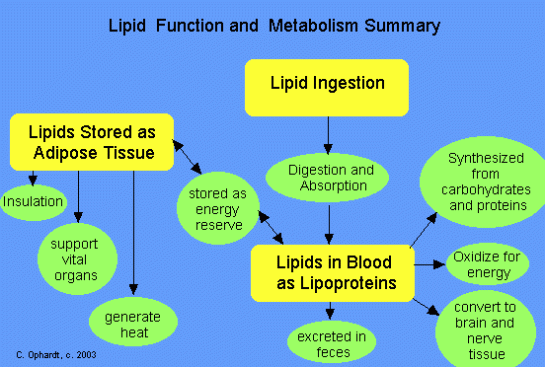Fatty acids
These are the defining constituents of lipids and are in large part responsible for the distinctive physical and metabolic properties. They are also important in non-esterified form.
In the body these are released from triacylglycerols during fasting to provide a source of energy.
Linoleic and linolenic acids are essential fatty acids, in that they cannot be synthesised by animals and must come from plants via the diet. They are precursors of arachidonic, eicosapentaenoic and docosahexaenoic acids, which are vital components of all membrane lipids.
Fatty acids in diet are short and medium chain length are not usually esterified. Once within the body they are oxidized rapidly in tissues as a source of ‘fuel’.
Longer chain fatty acids are usually esterified first to triacylglycerols or structural lipids in tissues.
Triacylglycerols
These form the primary storage form of long chain fatty acids for energy and structure formation of cells. These are composed of glycerol (1,2,3-trihydroxypropane) and 3 fatty acids to form a triester. Triglycerides are found in blood tests. Complete hydrolysis of triacylglycerols yields three fatty acids and a glycerol molecule. Polyunsaturated fatty acids are important as constituents of the phospholipids and form the membranes of the cells. Most of the natural fats and oils of commerce consist of triacylglycerols
Tri-, Di- and Monoacylglycerols
1,2-Diacylglycerols are formed as intermediates in the biosynthesis of triacylglycerols. These also function as second messengers in many cellular processes. Monoacylglycerols are produced when triacylglycerols are digested in the intestines of animals.
Sterols
Cholesterol is a ubiquitous component of all animal tissues. Most of it is present in the membranes. It occurs in the free form and esterified to long chain fatty acids (cholesterol esters) in animal tissues, including the plasma lipoproteins. Cholesterols are precursor of bile acids, vitamin D and steroidal hormones.
ref: http://www.elmhurst.edu/~chm/vchembook/620fattyacid.html

